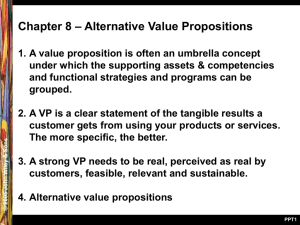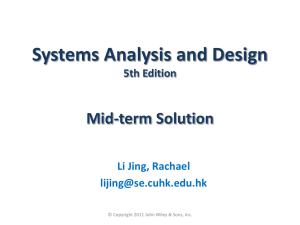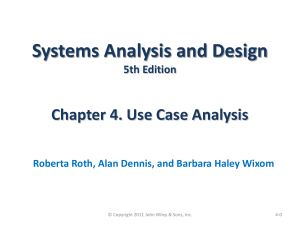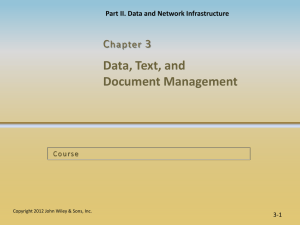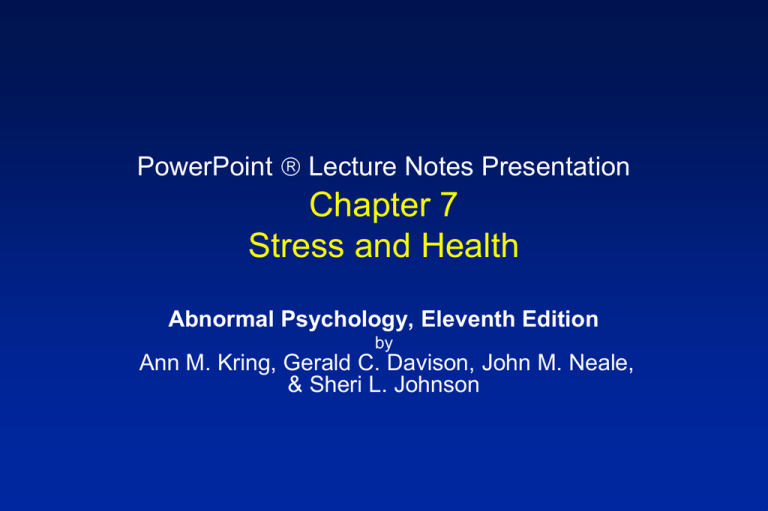
PowerPoint Lecture Notes Presentation
Chapter 7
Stress and Health
Abnormal Psychology, Eleventh Edition
by
Ann M. Kring, Gerald C. Davison, John M. Neale,
& Sheri L. Johnson
Psychological Factors Affecting
Medical Conditions
DSM-IV-TR Criteria
» A medical illness is present.
» Psychological factors have influenced the
course of the condition, interfered with
treatment, increased health risks, or
exacerbated symptoms.
Copyright 2009 John Wiley & Sons, NY
2
Stress and Health
Behavioral medicine
» Interdisciplinary approach involving medicine
and behavioral science
» Goals
– To understand, prevent, and treat illnesses
influenced by psychological factors
Health psychology
» Branch of psychology concerned with role of
psychological factors in health and illness
– Includes:
Stress and stress management
Prevention of disease
Copyright 2009 John Wiley & Sons, NY
3
What is stress? Selye’s General Adaptation
Syndrome
Stress as a response
Problem with
response-focused
definitions:
» Based on
physiological and
psychological
responses
» Similar responses can
occur to non-stressful
stimuli
– e.g., pleasurable
events
Copyright 2009 John Wiley & Sons, NY
4
What is Stress?
Stress as a stimulus
Stressors include:
» Boredom, catastrophic life events, daily hassles,
and sleep deprivation
Problem with stimulus-focused
definitions
» Based on nature of stimuli rather than
response
» Differences as to what constitutes a
stressor
– Major vs. daily hassles
– Acute vs. chronic events
Copyright 2009 John Wiley & Sons, NY
5
Definition of Stress
Subjective experience of distress in
response to perceived environmental
problems (Lazarus, 1966)
» Whether event is stressful depends upon
an individual’s perception or appraisal
– Emphasis on how we perceive or appraise the
environment
Copyright 2009 John Wiley & Sons, NY
6
Coping and Health
Coping
» Attempts to deal with problems and negative
emotions elicited by stressors
Two dimensions
» Problem-focused coping
– Taking action to solve problem
» Emotion-focused coping
– Making efforts to reduce negative emotional reaction
Avoidance coping
» Avoid acknowledging problem
» Neglecting to do anything to solve it
Copyright 2009 John Wiley & Sons, NY
7
Coping and Health
Effective coping varies by situation
» Distraction may be adaptive in some
situations (chronic pain) and maladaptive in
others (financial problems)
Positive emotions
» Smiling, laughing, seeing the humor in
things, finding ‘the silver lining’
» Can buffer or blunt the effect of stress
Copyright 2009 John Wiley & Sons, NY
8
Assessment of Daily Experiences
(ADE)
Measures the relationship between stress
& health
Less reliance on retrospective reports than
other measures
» Responses collected at the end of each day
Results:
» Increases in undesirable events and decreases
in desirable events precede onset of
respiratory illness (Stone et al., 1987)
Copyright 2009 John Wiley & Sons, NY
9
Figure 7.2 Mean Number of Desirable
Events Preceding Illness
Copyright 2009 John Wiley & Sons, NY
10
Figure 7.3 Mean Number of Undesirable
Events Preceding Illness
Copyright 2009 John Wiley & Sons, NY
11
Coping Orientations to Problems
Experience (COPE) Scale
Measures the types of coping used to
handle recent stressors
Coping methods of women with breast
cancer (Carver et al., 1993)
» Humor linked to less distress
» Avoidant coping linked to more distress
Copyright 2009 John Wiley & Sons, NY
12
Table 7.1 Scales
and Sample Items
from the COPE
Copyright 2009 John Wiley & Sons, NY
13
Social Support and Health
Types of social support
» Structural
– Networks of social relationships
Number of friends, marital status, etc
» Functional
– Quality of social relationships
Friends, family supportive and there when needed
Copyright 2009 John Wiley & Sons, NY
14
Figure 7.4 Stress and Social Support
Copyright 2009 John Wiley & Sons, NY
15
Theories of Stress-Illness Link
Most involve psychological and biological factors
» Diathesis-stress models
– Individual vulnerability to stress
Much research limited by self-report data
Stress-illness link mediated by:
» Changes in health related behaviors
– e.g., smoking, substance abuse, lack of exercise
» Changes in physiology
– e.g., cardiovascular reactivity, reduced immune system
functioning
Copyright 2009 John Wiley & Sons, NY
16
Biologically Based Theories
Allostatic Load
» Damage caused by prolonged exposure to
stress hormones (e.g., cortisol)
– Impaired immune system functioning
– Increased susceptibility to disease
Higher allostatic load effects predicted greater risk for
cardiovascular disease 2 years later (Seeman et al.,
1997).
Stress and the immune system
» Psychoneuroimmunology
– Study of how psychological factors impact immune
system
Copyright 2009 John Wiley & Sons, NY
17
Figure 7.5 Immune System Components
Copyright 2009 John Wiley & Sons, NY
18
Stress and the Immune System
Natural immunity
» Consists of macrophages and natural killer
cells which stimulates release of cytokines
– Cytokines
Key elements in the immune system
Trigger fatigue, fever and HPA axis activation to fight
infection
Excessively high levels linked to diseases in older
adults
Specific immunity
» Lymphocytes
– Respond more slowly
– T-helper and B cells.
Copyright 2009 John Wiley & Sons, NY
19
Stress and the Immune System
Prenatal stress can impact offspring behavior
and immune system functioning (Coe & Lubach,
2005)
» Rhesus monkey infants, whose mothers were
exposed to loud and unpredictable noise during
pregnancy, showed emotion regulation difficulties.
– Also exhibited immune system disturbances
Stress can trigger the release of cytokines such
as interleukin-1 and interleukin-6, as if the body
were fighting off an infection (Maier & Watkins,
1998).
» Inflammation and higher levels of IL-6 linked to
coronary heart disease, arthritis, multiple myeloma,
non-Hodgkin’s lymphoma, osteoporosis, and type
2 diabetes
Copyright 2009 John Wiley & Sons, NY
20
Psychological Theories
Psychodynamic
» Anger-in theory (Alexander, 1950)
– Unexpressed hostility → negative emotions which impact health
Cognitive
» Appraisal of stressor is key
– Appraising life events and experiences as exceeding one’s resources may
be at risk for adverse health effects
Personality
» Link between chronic negative emotion and cardiovascular
disease
» Negative emotions also linked to reduced immune system
functioning
– Slowed antibody production following a flu vaccine (Rosenkranz
et al., 2003)
Copyright 2009 John Wiley & Sons, NY
21
Cardiovascular Disorders
Diseases involving heart and blood
circulation system
Two cardiovascular disorders affected
by stress:
» Essential hypertension
» Coronary heart disease
Copyright 2009 John Wiley & Sons, NY
22
Essential Hypertension
High blood pressure
» Increases risk for:
– Heart attack, stroke, atherosclerosis (clogged arteries)
Essential hypertension
» No evident biological cause
» 90% of all hypertension is essential
Hypertension are found in about 20 percent of
the US adult population
» 2x as frequent in African-Americans as in whites
Copyright 2009 John Wiley & Sons, NY
23
Essential Hypertension
Systolic pressure
» Arterial pressure
when the ventricles
contract and the
heart is pumping
Diastolic pressure
» Arterial pressure
when the ventricles
relax and the heart is
resting
Normal levels
» 120 systolic
» 80 diastolic
High levels
» 140 or higher systolic
» 90 or higher diastolic
Copyright 2009 John Wiley & Sons, NY
24
Etiology: Role of Psychological
Stress
Real-world events (e.g., stressful interviews, natural
disasters, job stress) can increase BP
Stressful lab tasks trigger BP increases
» Negative mood induction, cold pressor test, giving a speech,
mental arithmetic, etc.
Unethical to test whether short term lab induced BP
increases lead to prolonged hypertension
Ambulatory BP monitoring studies:
» Both positive and negative emotions linked to increases in
BP
» Paramedics high in anger and defensiveness had higher BP
during stressful calls.
Copyright 2009 John Wiley & Sons, NY
25
Etiology: Role of Anger
Anger
»
Inappropriate and excessive levels
–
–
Angering easily most problematic, especially for men
In women, anger suppression, problematic
Type A behavior (Friedman and Rosenman)
» Three components
1. Achievement striving/competitiveness
2. Urgency/impatience
3. Hostility
Copyright 2009 John Wiley & Sons, NY
26
Etiology: Role of Anger
CARDIA study
» Urgency/impatience increased risk of
developing hypertension
– Especially for men
» Hostility increased risk for both genders
» Achievement striving/competitiveness
– Predictor only for white men
Copyright 2009 John Wiley & Sons, NY
27
Biological Risk Factors for Essential
Hypertension
Cardiovascular reactivity
» Extent to which BP and HR increase in
response to stress
» Predicts later development of high blood
pressure and increased risk of hypertension
» Influenced by heredity
– Genes linked to the neurotransmitter serotonin
Especially one or two long alleles in the promoter
region of the serotonin transporter gene
Copyright 2009 John Wiley & Sons, NY
28
Coronary Heart Disease
Two forms
» Angina pectoris
– Intermittent chest pain caused by insufficient
oxygen to heart (ischemia)
– Silent ischemia
Insufficient oxygen without pain
– Triggered by physical exertion or stress
» Myocardial infarction (heart attack)
– Also caused by insufficient oxygen to heart
Total blockage of coronary artery
– Often results in permanent heart damage
Copyright 2009 John Wiley & Sons, NY
29
Table 7.2 Risk Factors for Coronary
Heart Disease (CHD)
Age
Cigarette smoking
Diabetes
Elevated BP or serum cholesterol
Alcohol
Obesity
Lack of exercise
Sex (men more likely to have CHD)
Copyright 2009 John Wiley & Sons, NY
30
Etiology: Stress and Mycardial
Infarction
Acute
» Physical exertion and episodes of anger
» Acute stress such as physical attack
Chronic
» Marital conflict
» Financial worries
» Job strain
– Excessive work load, lack of control over decision
making, no opportunity to fully use one’s skills
Copyright 2009 John Wiley & Sons, NY
31
Etiology: Other Psychological Risk
Factors
Type A behavior
» Predicted CHD in some studies but not all
» Best type A predictors:
– Anger, hostility, cynicism
Anger and hostility also related to other variables
linked to CHD:
»
»
»
»
»
»
Greater blood pressure reactivity to stress
Higher levels of cholesterol
Abnormal calcium deposits
Cigarette smoking and alcohol use
Metabolic syndrome among adolescents
Greater activation of platelets
Anxiety and depression also linked to CHD
Copyright 2009 John Wiley & Sons, NY
32
Figure 7.6 Major Structures of the
Respiratory System
Copyright 2009 John Wiley & Sons, NY
33
Asthma
Severe constriction of the airways
» Air passages narrow
– Wheezing and labored breathing
» Rales
– Whistling sound on exhalation
» Person feels as if they are suffocating
Biological risk factors
»
»
»
»
Respiratory infection
Allergens
Air pollution
Exercise
Stressful life event and negative emotions
» Stress and negative emotion linked to lower peak flow and
more reports of asthma symptoms.
Copyright 2009 John Wiley & Sons, NY
34
Figure 7.7 Effect of Parenting Problems and
Mothers’ Stress on Frequency of Asthma in
Children
Copyright 2009 John Wiley & Sons, NY
35
AIDS
AIDS
» Acquired immunodeficiency syndrome
More than 25 million people worldwide have
died of AIDS
In 2007, more than 33 million people are HIVpositive
Worldwide, women now account for nearly 50
percent of people infected with HIV
In US, African American and Hispanic women
are 17 times more likely than white women to
become infected.
Copyright 2009 John Wiley & Sons, NY
36
AIDS
Prevention through behavioral change
» Modifying sexual practices
– Condom use
– Encouraging monogamy or reducing number of
sexual partners
– Abstinence only programs have not proven
effective in decreasing risky behavior or
reducing the risk of developing HIV.
Copyright 2009 John Wiley & Sons, NY
37
AIDS
Strategies for effective prevention
» Accurate information about HIV transmission
» Explain risk factors (e.g., sharing needles)
» Identify cues to high-risk situations (e.g.,
alcohol use)
» Provide instruction in condom use
» Teach sexual assertiveness skills
– How to resist pressure to have sex
» Community efforts to make safer sex the norm
Copyright 2009 John Wiley & Sons, NY
38
Gender and Health
Women live longer than men
Women in poorer health than men
» Higher rates of diabetes, lupus, arthritis, anemia
» Formerly believed that estrogen protected women
from cardiac disease
– Hormone replacement studies fail to find reduced risk
Women less likely to exhibit Type A Behavior
» Not necessarily less likely to experience anger
» More likely to suppress
Copyright 2009 John Wiley & Sons, NY
39
Gender and Health
Gender differences in mortality decreasing.
May be due to:
» Increasingly similar lifestyles
– More women smoke and drink
Lung cancer leading cause of cancer death since 1987
In 2004, only one state earned a passing grade in efforts to
curb smoking in women
» Differences in disease identification and treatment
– Little public awareness that cardiovascular disease is the
main cause of death in women
– Stress test not a good predictor of heart disease risk in
women, especially when no pain is present
– Women less likely to receive referral for cardiac rehab
following heart attack.
Copyright 2009 John Wiley & Sons, NY
40
Socioeconomic Status, Ethnicity, and
Health
Low SES linked to higher rates of health
problems and mortality from all causes
Differences attributed to:
» Greater stress associated with SES
» Environmental constraints
– Less access to healthy foods
– More liquor stores
– Less opportunity to exercise
» Limited access to health services
» Stress associated with discrimination and prejudice
Copyright 2009 John Wiley & Sons, NY
41
Socioeconomic Status, Ethnicity, and
Health
Mortality rate in US for African
Americans 2x as high as for whites
» Some risk factors more common in people
of color (e.g., smoking, obesity, hypertension)
» Both ethnicity and SES important:
– Lower family and neighborhood SES associated
with greater cardiovascular reactivity for African
American children and adolescents, but only
lower family SES was associated with greater
cardiovascular reactivity among white children
and adolescents (Gump et al., 1999)
Copyright 2009 John Wiley & Sons, NY
42
Stress Management
Techniques anyone can use to cope with
stress
» Relaxation training
– Muscle relaxation
– Deep breathing
» Cognitive restructuring
– Modify maladaptive thoughts
– Enhance perception of control
» Behavioral-skills training
– Time management, prioritizing, assertiveness
» Environmental-change
– Workplace alterations, increase social support
Copyright 2009 John Wiley & Sons, NY
43
COPYRIGHT
Copyright 2009 by John Wiley & Sons, New
York, NY. All rights reserved. No part of the
material protected by this copyright may be
reproduced or utilized in any form or by any
means, electronic or mechanical, including
photocopying, recording or by any information
storage and retrieval system, without written
permission of the copyright owner.
Copyright 2009 John Wiley & Sons, NY
44


